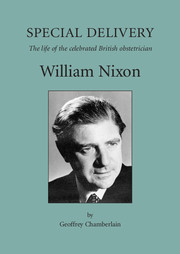Book contents
- Frontmatter
- Contents
- Foreword
- Preface
- Introduction
- Acknowledgements
- Chapter One Early Days (1903–1918)
- Chapter Two The Medical Student (1922–1927)
- Chapter Three Postgraduate Training (1927–1934)
- Chapter Four Consultancies: at Home and Away (1935–1939)
- Chapter Five The War Years (1939–1945)
- Chapter Six The Obstetric Unit in Nixon's Time (1946–1966)
- Chapter Seven Research in the Obstetric Unit (1946–1956)
- Chapter Eight Teaching at UCH (1946–1966)
- Chapter Nine Nixon the Man (1928–1965)
- Chapter Ten Last Days
- APPENDICES
- SOURCES
- INDEX
Chapter Four - Consultancies: at Home and Away (1935–1939)
Published online by Cambridge University Press: 05 February 2014
- Frontmatter
- Contents
- Foreword
- Preface
- Introduction
- Acknowledgements
- Chapter One Early Days (1903–1918)
- Chapter Two The Medical Student (1922–1927)
- Chapter Three Postgraduate Training (1927–1934)
- Chapter Four Consultancies: at Home and Away (1935–1939)
- Chapter Five The War Years (1939–1945)
- Chapter Six The Obstetric Unit in Nixon's Time (1946–1966)
- Chapter Seven Research in the Obstetric Unit (1946–1956)
- Chapter Eight Teaching at UCH (1946–1966)
- Chapter Nine Nixon the Man (1928–1965)
- Chapter Ten Last Days
- APPENDICES
- SOURCES
- INDEX
Summary
Imitate him if you dare,
World besotted traveller, he
Served human liberty.
Epitaph on Jonathan Swift (1931) WB YeatsThe path to consultancy in the early 1930s was a steep and hard one. Most students, after qualifying, became general practitioners, many joining family practices established by their fathers. A few went into the armed services and even fewer into academic medicine. The remainder (about one-fifth) took the steep and stony road towards becoming a specialist working in a hospital. The forward way for these students involved postgraduate examinations at the universities and Royal Colleges while gaining experience by taking expanding responsibility for patient care in posts of increasing seniority in specialist hospitals. The bastions of these were the teaching hospitals of London and some of the provincial universities. William Nixon had taken all the right steps: he had been a house surgeon to powerful men, he had worked in paediatric surgery, then in increasingly senior posts in obstetrics to the satisfaction of people like Alec Bourne at St. Mary's and at Queen Charlotte's Hospital. He worked in gynaecology at the Samaritan and Soho hospitals, coming back as a registrar for some years at his own teaching hospital.
In consequence, in 1934, when he was thirty-one, he applied for and was appointed as the second surgeon to the outpatients in obstetrics and gynaecology at St. Mary's Hospital. In those days, surgeons were divided into those who had inpatient facilities with the right to admit patients to beds and those who did not.
- Type
- Chapter
- Information
- Special DeliveryThe Life of the Celebrated British Obstetrician, William Nixon, pp. 27 - 37Publisher: Cambridge University PressPrint publication year: 2004



